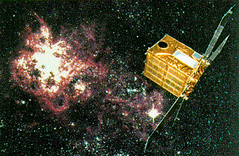
Ginga was launched by the Japanese Institute of Space and Astronautical Sciences (ISAS) on February 5, 1989, and it observed cosmic X-rays until November 1991. Ginga was originally named Astro-C, and was the third in the ISAS series of X-ray astronomy satellites. It was renamed “Ginga” on launch, a name which means “galaxy” in Japanese. Ginga was the first X-ray astronomy observatory for which ISAS collaborated with institutions in the United States. While NASA was not one of the collaborators, the US participation in ASCA paved the way for NASA to collaborate with ISAS in future missions.
The collaboration between Japan and the US on Ginga came about when Minoru Oda (a Japanese scientist sometimes known as the “father of Japanese X-ray astronomy”) visited Los Alamos National Laboratory (LANL) in New Mexico. A group at LANL had been studying gamma-ray bursts, and seemed to be natural partners on a gamma-ray burst monitor for Ginga. The Japanese also collaborated with institutions in the United Kingdom to design and construct detectors onboard Ginga. Ginga, thus, marked the beginning of international collaboration for Japan in X-ray astronomy, opening the door to future collaborations.
Use the links below or in the sidebar to learn more about Ginga.